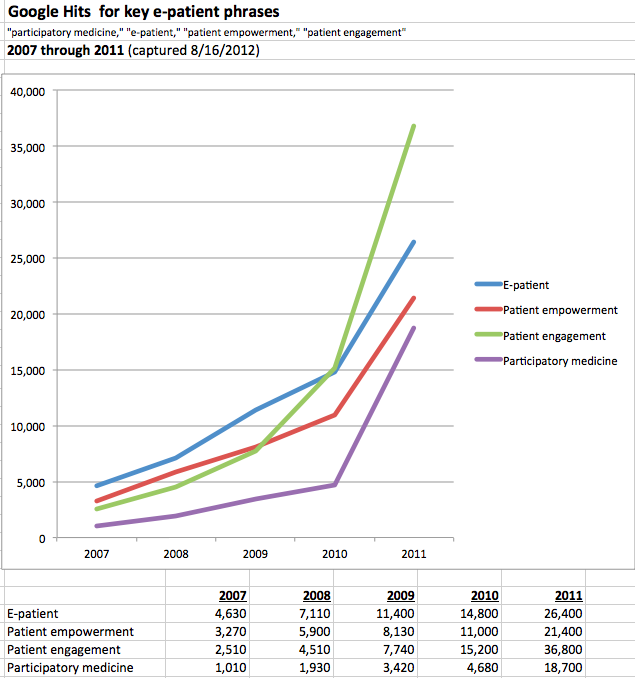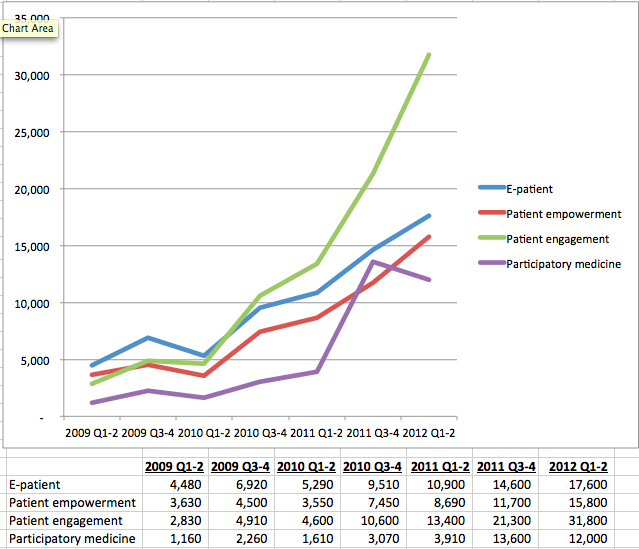 We’re not in it for “the eyeballs,” as they say in the world of website marketing: this isn’t a blog that obsesses about pageviews, unique visitors etc, for purposes of selling ads. (We don’t do ads, we don’t do link exchanges, etc.) But the Society for Participatory Medicine sure is working to increase the world’s conversations about, well, participatory medicine.
We’re not in it for “the eyeballs,” as they say in the world of website marketing: this isn’t a blog that obsesses about pageviews, unique visitors etc, for purposes of selling ads. (We don’t do ads, we don’t do link exchanges, etc.) But the Society for Participatory Medicine sure is working to increase the world’s conversations about, well, participatory medicine.
So rather than focus on traffic to this site, I like to count how many times the phrases we care about show up anywhere in Google search results. Once or twice a year I search for these phrases, and record how many new pages Google says they’re on:
- “e-patient”
- “patient empowerment”
- “patient engagement”
- “participatory medicine”
A few observations:
- Look at the green line – patient engagement: it’s pretty easy to see the impact of government regulations! (I’m assuming that’s why that term has zoomed past the others since Meaningful Use made patient & family engagement a Federal policy.)
- In 2011 participatory medicine quadrupled(!). Any idea why?
SPM was formed early in 2009, so in a sense the baseline year is 2008: the question is, how does each phrase compare to 2008? I’d say: woot.
I thought you’d never ask. To make sense of that we have to break it into half-years.
It seems 2012 is sure strong: patient engagement has 31,000 new hits so far this year, almost as many as all of last year. Again, I’m sure that’s Meaningful Use, plus PCMH regulations (patient centered medical home), which (especially for PCMH 2011) require patient engagement.
Interesting: participatory medicine had a big uptick last fall, matching the peak in fall of 2009. I’d speculate that both were because of the fall conference season, but to assess that I’d have to plow through the search results – not gonna happen.
Bottom line, we’re zooming in 2012. Keep it up: change the world’s conversations!
p.s.: Careful what you’re measuring
In any metrics, e-patients and clinicians and geeks need to be careful about what got measured. As I’ve done this for a few years, I’ve discovered that Google keeps changing its rules: last year this time, previous years’ numbers became different, so they must have changed what they count
I speculated that maybe their crawlers had found a bunch of extra stuff, but this year the numbers dropped by at least 5x, across the board.
Nobody’s life depends on this so I’m not digging into it, especially since the general pattern for those years is unchanged. But it’s a good lesson: always check and double-check – were they measuring what you thought they were? Were they even measuring what they thought they were?
p.p.s: If you want to dig into that issue and you’re at grad-student level, a good book is Between the Lines, by SPM member Marya Zilberberg MD. It’s not for the faint of heart, but if you’re into meaty statistical thinking, it’ll give you plenty to chew on! She documents, at length, the many ways researchers may not be measuring what they think they are, and might even not be measuring something worth measuring.







Dave, I really enjoyed reading your post today and seeing that we “play” the same stats game!My mantra is “patient rights”, “cancer patient rights” and relevant phrases including patient empowerment, patient engagement,participatory medicine,and more. I check both in Greek and English on Google and I have remarked the same results as you, but far less in Greek language. I think I will try it also for French, German and Dutch, it will show people’s, speaking these languages, interest for these concepts..
It might not be very accurate, as many non-native speakers of these languages use them, but I believe it will be indicative of the penetration of the concepts in Europe.
Kathi, do you keep a record of this over time?
Re “might not be very accurate,” my view is that we can only interpret it as exactly what it is: how many google hits there are, nothing more. And, that’s worth something.:)
I have started it in 2010, when I wrote “Are there e-patients in Greece?”, a post about e-patients and wanted to know if the term existed in Greek pages – see here http://bit.ly/Px44V0 in the middle of the page there is a table: Search terms in English and Greek. There are two columns: one for the terms in English and one for the terms in Greek
No, I have not kept data as these change, I would say daily. But I have in the making a post about the terms Greek patients use to search for cancer and healthcare information, (sounds fascinating to me) and will include data of google searches for those…